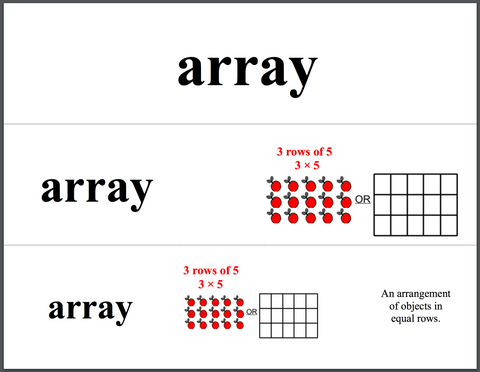Use these 5 actionable strategies today to grow your students' math vocabulary
SCROLL DOWN TO THE BOTTOM TO GET YOUR FREE COPY OF OUR MATH VOCABULARY TOOLKIT
Do the bolded words mean the same thing in the following examples?
The third cup was roughly two-thirds full of water. The kids were rough-housing and banged a foot into the table, which knocked over the cup. The water spill was a foot wide.
He placed an even number of spoons on the even surface of the table. If he takes one away, there will be 3 spoons left on the left side.

As educators, we know firsthand how tricky math vocabulary can be for our students- especially using exact, precise math words correctly.
Based on your experiences in the classroom, you probably already know that students with math disabilities- especially those who are also English language learners or have language disabilities- will have an especially hard time learning new math words. Using correct math words can seem like learning a new language!
While this is true, you should also know that YOU are an important factor in students’ learning. YOU matter and there are actionable strategies YOU can implement to grow your students’ knowledge of math words.
In this post, you will learn 5 actionable ways to improve your students’ math vocabulary- 5 strategies that you can implement today and that work for students with disabilities.
AND, if you make it down to the bottom of the post, you'll find my FAVORITE resource that I use to help build my math word wall.
Language in the math classroom
When you think of learning new vocabulary words, English Language Arts class comes to mind first, right? We tend to think of math as all numbers, but there’s actually quite a bit of language learning that goes on in the math class, too.
Students need to learn the two (or more) different meanings for certain math words. Words they thoughts they knew, like face, mean something else once math class starts.
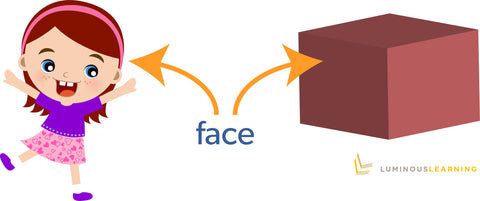
They need to understand and use these hard to say words, like quadrilateral.
They finally understand and remember what those math words mean, like decimal point. But now they learn that we sometimes use different words in different contexts. When we read a number aloud that has a decimal point, we don’t call it “decimal point,” we say “and.”
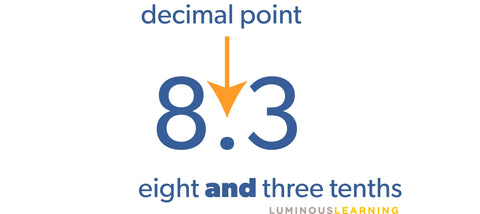
Oy vay! You know what else makes teaching math words so difficult? The fact that almost 50% of children with math disabilities ALSO have reading disabilities!
So not only do many of our struggling math students have a hard time understanding the meaning of math words, but they also have a hard time with expressive and receptive language.
A double whammy, but later I’ll show you that all is not lost. Our students with math and reading disabilities CAN learn to understand and use math words correctly, with the right supports. We’ll get into what those supports are later, but first:
Why should we focus on teaching math vocabulary?
Well, for a few reasons:
We use language to communicate.
Let’s say you’re working with Alice and you ask her to explain the steps she took to solve a fraction division problem.
She says, “I took this one and turned it like this, so now it’s the other. Then I timesed the top and the bottom, which gave me the answer.”
Does that sound like something some of your students might say? My struggling students tended to use a lot of vague words- “things” “this one” “like this”- instead of exact math language.
Using more precise language, Alice might have said, “I took the second fraction and turned it upside down, so it became the reciprocal. Then I multiplied the two numerators and the two denominators, which gave me the quotient.”
Sure does sound a lot more mathy, right? But more importantly, I understand what Alice did. Her use of precise language conveyed her understanding of the procedure and helped me get an insight into what she was thinking and doing.
Using the right math language helps us to have a conversation and understand what the other person means.
If math language isn’t explicitly taught, children learn to disregard math words and only pay attention to the numbers.
For example, let’s say you give Alice the following problem: "Nancy has 32 pretzels to share with 8 friends. How many pretzels will each friend get?"
Instead of figuring out what all those words mean, Alice narrows her focus to the numbers. She chooses an operation based on an arbitrary metric, then voilà! She has an answer.
Alice might think, “32 is bigger than 8, so maybe I need to subtract. 32 minus 8 is 24.”
Is it the right answer to the word problem? No.
But more importantly, did Alice have the chance to engage in critical thinking and flex her problem-solving skills? No.
If math vocabulary is so important, how do we teach it?
5 high impact strategies to teach math vocabulary:
1) Start with what they know and use student-friendly definitions.
Let students use their own informal language to describe math concepts and ideas when you first introduce them. For example, Ms. Williams is introducing parallelograms to her class and calls on Eduardo to share his thinking:

Notice that Ms. Williams acknowledged and repeated back Eduardo’s observations about the rhombus, which reaffirms that he already has some knowledge about shapes. His teacher then builds on this knowledge by rephrasing his everyday language using the correct math words: rhombus instead of diamond and vertex instead of corner.
Teaching tip: Model the correct use of math language. You should be careful to use precise math language as you talk about math ideas with your students and rephrase new math words. For example, "Let's take a look at the area, or inside space, of the shape. We already know the area is 8 square units…"
2) Explicitly teach new math words and give students multiple exposures to math words.
When we teach vocabulary in Language Arts class, we don’t expect students to understand the words on their own. We isolate the words, help students sound them out, provide definitions, and give examples. We review new vocabulary words many times before we expect students to know them.
Same goes for the math class.
Math words need to be made explicit to students, defined, and shown in context, with examples.
Students need to hear novel math words and practice using the words themselves many times before the words become part of the child’s own language. You can increase children’s exposure to math words by:
- Pre-teaching: At the beginning of a new unit, tell students the new words they’ll be learning throughout the unit. As you introduce each new word, show an image and explain what it means.
- Teaching: Teach math words through explicit instruction. Pull out those images and examples you used when you pre-taught the words. Show how the novel math words fit together with concepts they already know. Add the new math words to your classroom word wall and/or students’ individual word walls. Use the new words in conversations you have with students.
- Re-teaching and reviewing: When the unit is over, review all the new math words you taught. Celebrate the fact that students learned new words and grew their ability to communicate mathematically. Have students turn and talk with a partner, explaining what each new math word means. Have students draw pictures that show examples and non-examples of each math word.
Teaching tip: Research on word learning has found that teaching vocabulary in context works better than teaching definitions in isolation.
In other words, don’t show a word and its definition and expect students to memorize the meaning of the word. Try to show the meaning in context and have students draw or act out the meaning, as much as possible.
For example, don’t say this: Perimeter is the measure of the boundary of a closed geometric figure. Who can repeat back what perimeter means?
Instead, say this: Perimeter is the distance around the outside of a shape. Think of the fence around the school yard. The fence hugs the perimeter of the yard. Let’s take a walk around the perimeter of our classroom. Where should we start?
3) Set up a classroom math word wall and individual math word banks.
[Disclaimer: Some of the links below are affiliate links, which means I may get paid a commission if you purchase through those links, which comes at no cost to you.]
Math vocabulary words that are relevant to the current unit should be displayed visibly in the classroom. I like to print my math vocabulary cards on thick cardstock, like this one.
Each vocabulary card should include the word in large font along with a meaningful image and simple definition (sometimes I leave out the definition if the image makes it clear what the word means.)
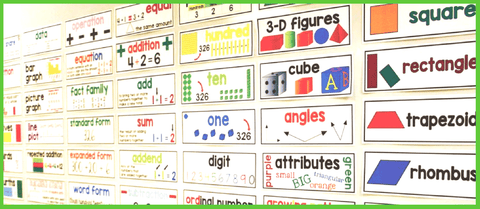
Struggling to come up with kid-friendly definitions of a math word? My go-to resource is Mathisfun.com. If you look up the word in their search bar, you'll usually find a kid-friendly definition and image.
Sometimes it can be hard to get good images to use as part of your word wall. You can always draw an image directly on the cardstock. You can also do a google search for “royalty free stock images” or search for images on Teachers Pay Teachers, which has some low-cost clipart.
Once you set up your word wall, don't let it sit there, gathering dust! Make your word wall come alive with these 7 activities:
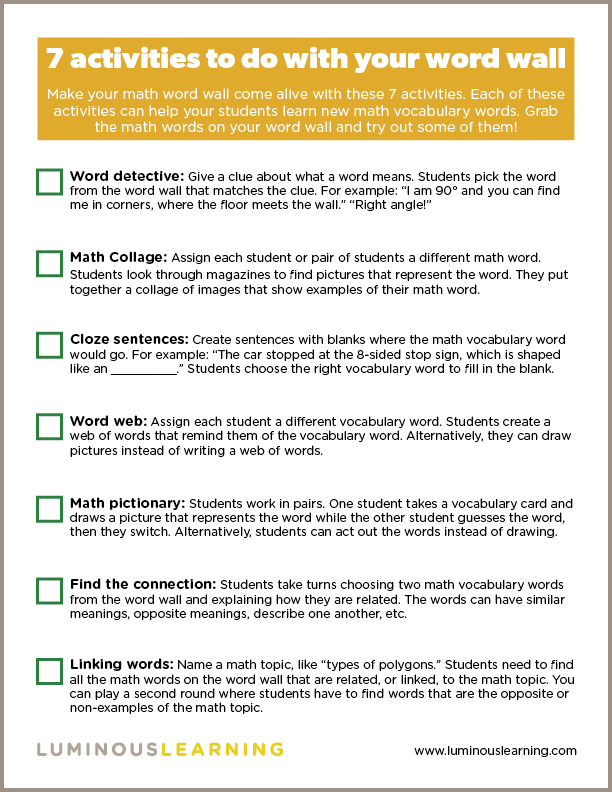
Scroll down to the bottom to get a FREE copy of our word wall activities checklist.
I also have my students create their own personal word walls or word banks.
Some years I have students fill out a graphic organizer (like the Frayer Model, which we'll see below) for each new math word. They keep their Frayer Models stored in a math journal or binder and can access their own personal math dictionary whenever they need to.
Other years I've had students create math dictionaries on index cards, which they keep on a ring. They write the math vocabulary word on one side of the index card and the definition or a picture on the other side.
What I like about personal word banks is that each student in my class had a unique collection of words. No two students are the same and no two students are trying to learn the same math words. This is a great way to differentiate for different levels of learners.
4) Use graphic organizers.
Use a graphic organizer for students to record and reinforce their understanding of math words. In addition to the Frayer Model shown below, you can use Venn Diagrams, semantic maps, word banks, etc.
Frayer Model
The Frayer Model is my favorite graphic organizer that I like to use when teaching math vocabulary.
In the Frayer Model, students write the word in the center of the graphic organizer. In the surrounding boxes, they list the definition, characteristics, and provide examples and non-examples.
The examples and non-examples that students draw in the Frayer Model are especially powerful ways to reinforce what a word means and doesn't mean.
Scroll down to the bottom to get a FREE copy of our place value arrow cards.
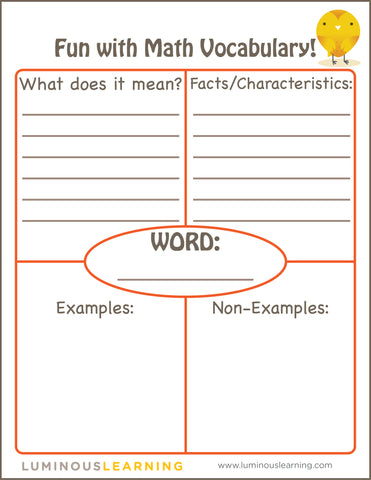
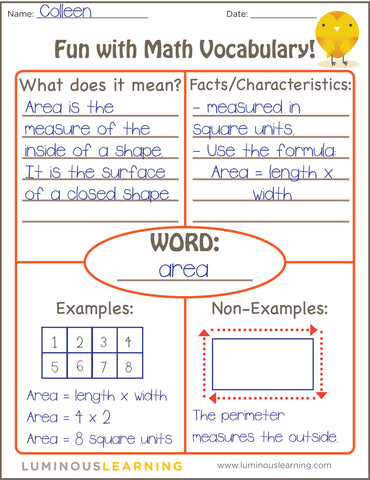
Journaling is a great way to reinforce the use of math language. At the end of a lesson, have students answer specific prompts in their math journals.
For example:
- Today in math, I learned...
- One problem I solved was...
- Two ways to solve this problem are...
As students write about what they learned in math class and how they solved specific problems, they are reflecting on the newly taught math concepts. They also have practice writing and thinking about new math words they just learned.
Encourage your students to use the word wall or their own personal graphic organizers to incorporate correct math vocabulary words in their journals.
Wrapping it up:
Think about the special education students in your class.
They might struggle to understand and use correct, precise words when expressing their ideas in all content areas, including math. But they won't absorb new math words automatically just by hearing the words during your lesson.
Instead, the best approach is to introduce new vocabulary directly through explicit instruction, in the context of meaningful math examples, and indirectly through conversation.
Hopefully, some of the strategies above will help you teach math vocabulary and help your students learn new math words.
If you want to learn more about vocabulary instruction, two of my favorite books are:
- Building Academic Vocabulary: Teacher's Manual by Marzano and Pickering
- Bringing Words to Life: Robust Vocabulary Instruction by Beck, McKeown, and Lucan
(note that these books aren't specific for math vocabulary instruction, but you can apply the knowledge in the books to teaching math words)
But before we go, I have one last resource to share with you...
MY FAVORITE MATH WORD WALL RESOURCE
Ok, I did promise you earlier in this post that I would share my favorite math word wall resource.
drumroll::
Not only do they list the words students should be learning in each grade, but they created cards, with definitions and images, that you can print and post on your word wall.
Here's an example:
